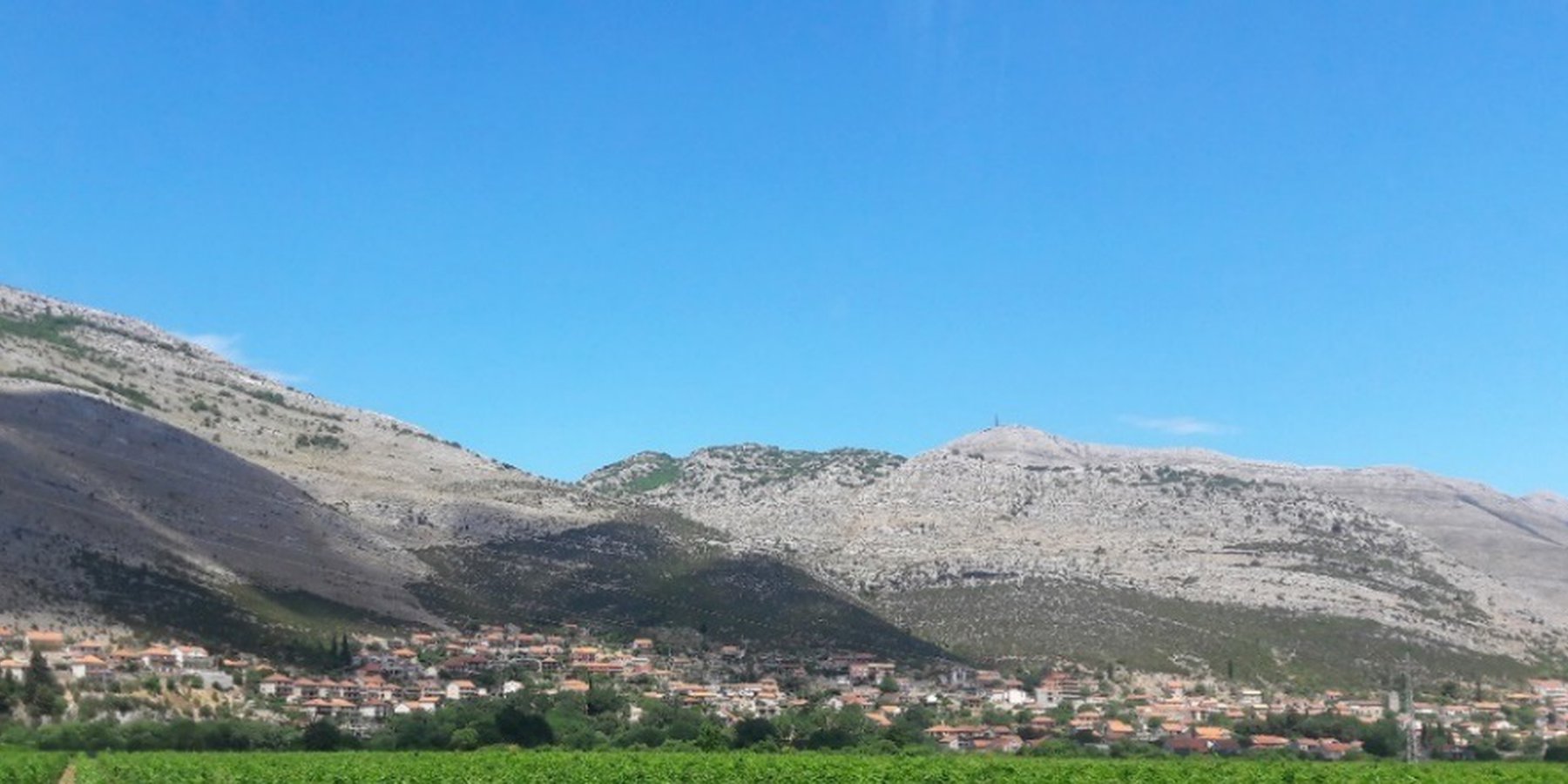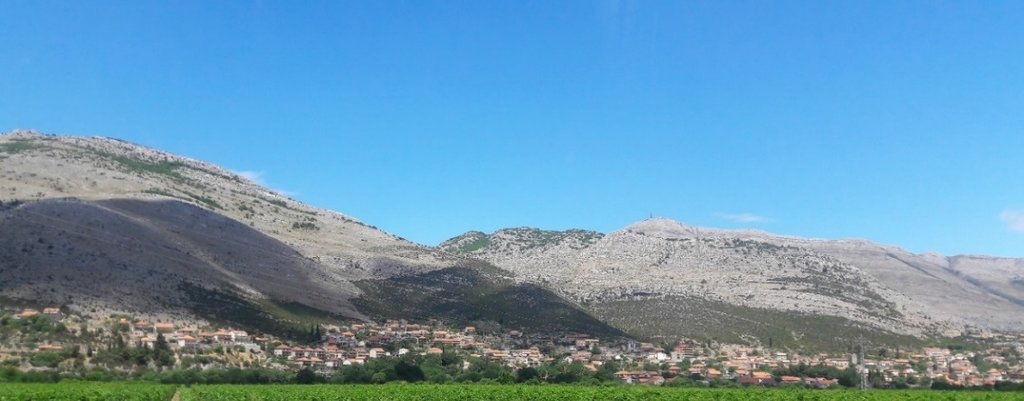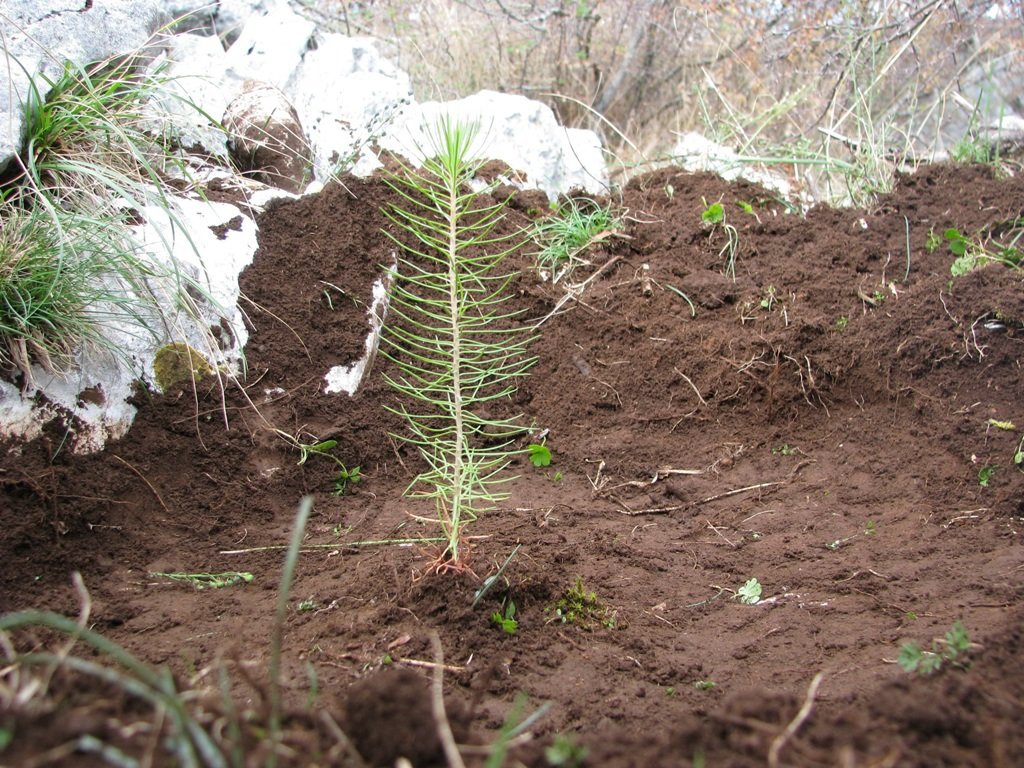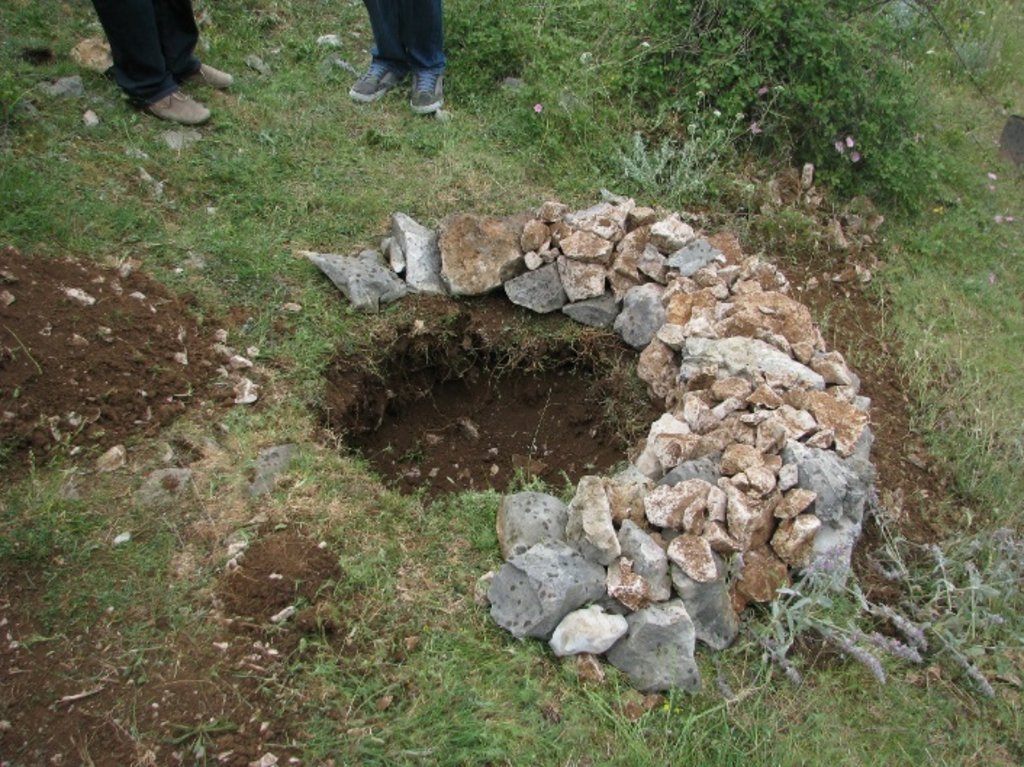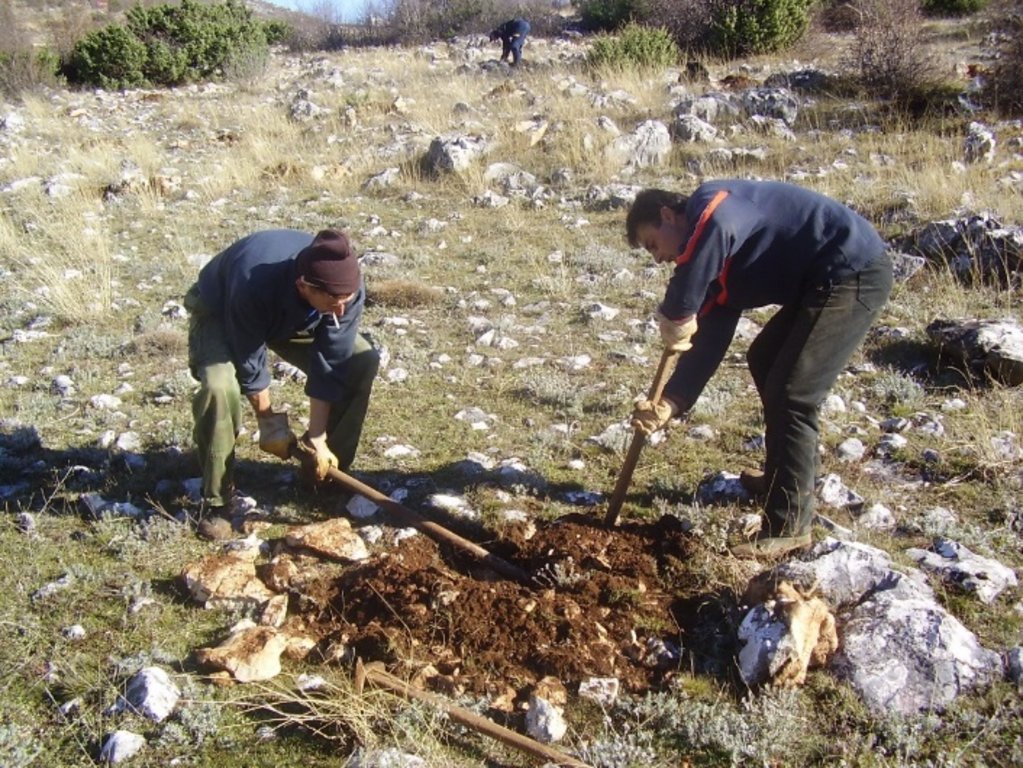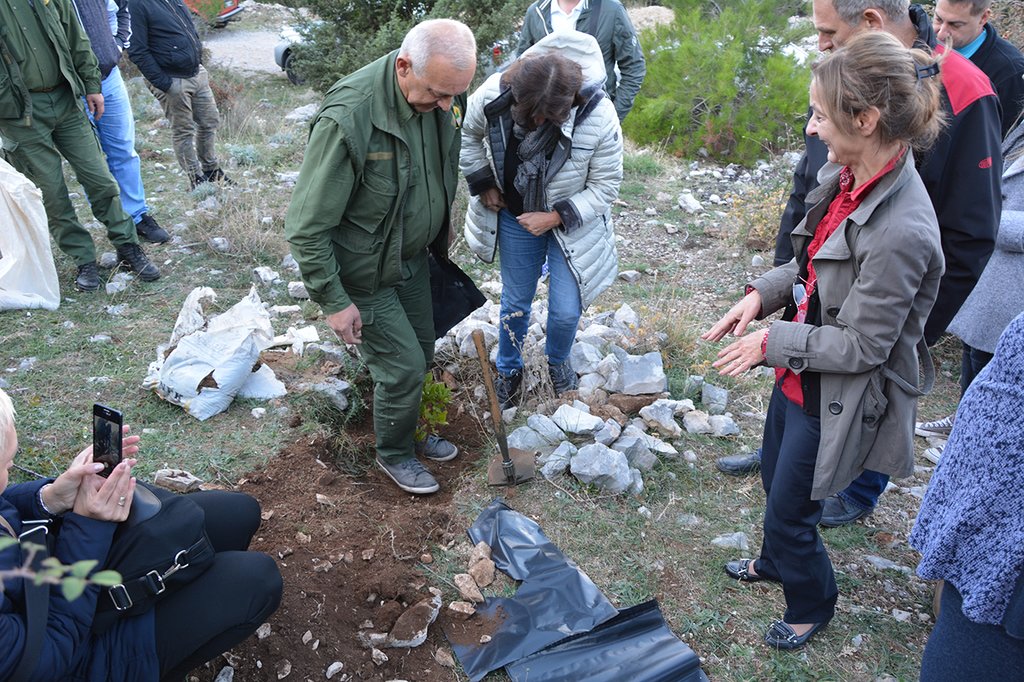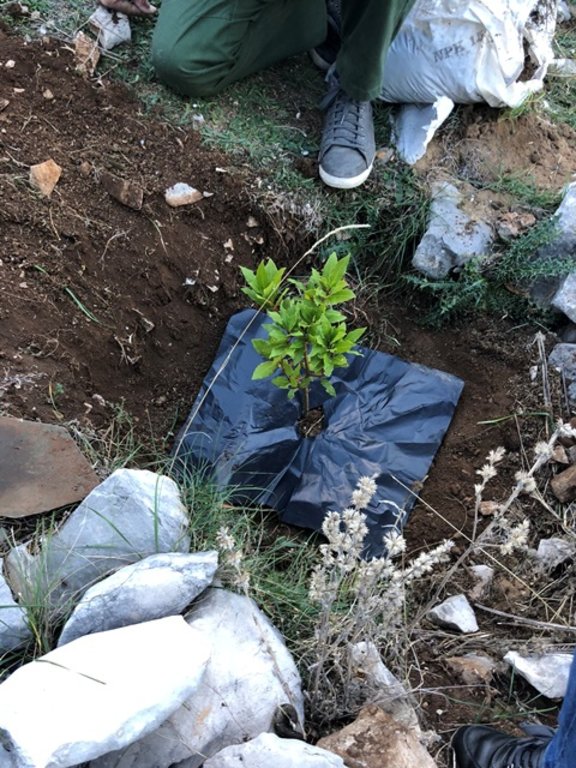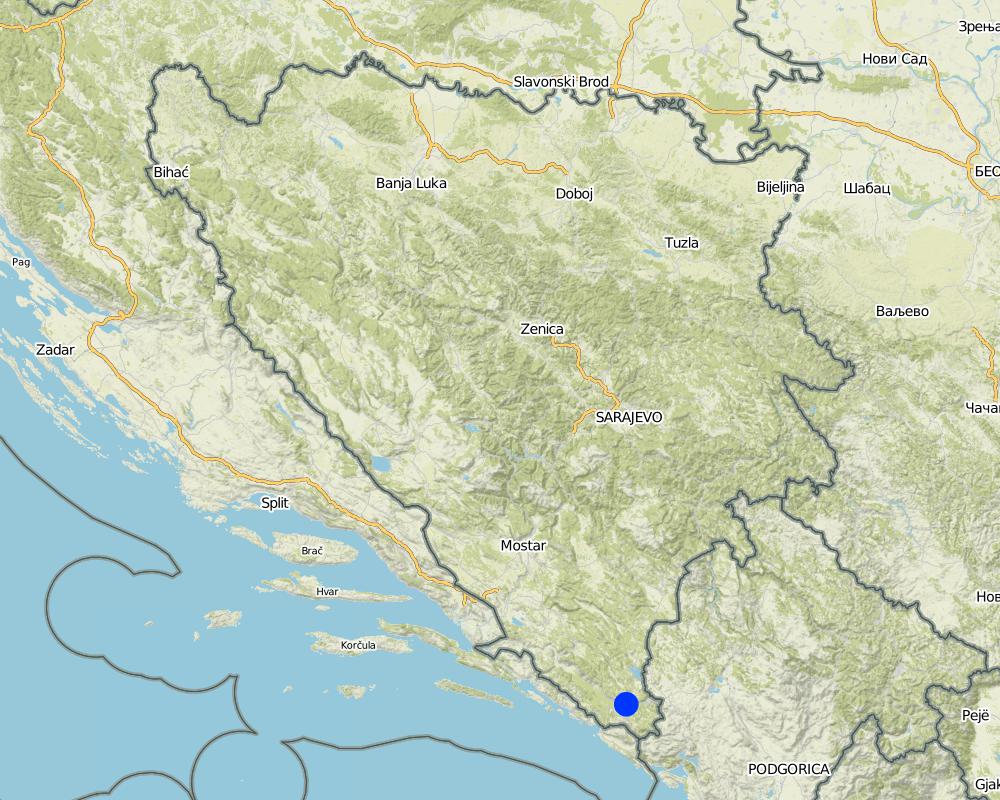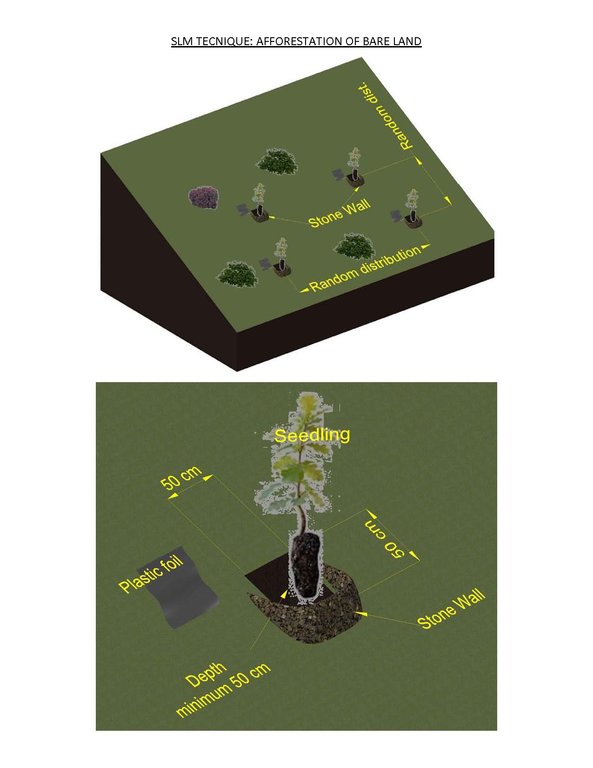Afforestation of bare land in karst areas [Bosnia and Herzegovina]
- Creation:
- Update:
- Compiler: Marijana Kapović Solomun
- Editor: –
- Reviewer: THEODORA FETSI
Pošumljavanje goleti
technologies_4367 - Bosnia and Herzegovina
View sections
Expand all Collapse all1. General information
1.2 Contact details of resource persons and institutions involved in the assessment and documentation of the Technology
Key resource person(s)
land user:
Vasiljević Mirela
Center for Karst Management
Bosnia and Herzegovina
Name of project which facilitated the documentation/ evaluation of the Technology (if relevant)
Decision Support for Mainstreaming and Scaling out Sustainable Land Management (GEF-FAO / DS-SLM)Name of the institution(s) which facilitated the documentation/ evaluation of the Technology (if relevant)
University of Banja Luka (UNIBL) - Bosnia and Herzegovina1.3 Conditions regarding the use of data documented through WOCAT
The compiler and key resource person(s) accept the conditions regarding the use of data documented through WOCAT:
Ja
1.4 Declaration on sustainability of the described Technology
Is the Technology described here problematic with regard to land degradation, so that it cannot be declared a sustainable land management technology?
Nee
1.5 Reference to Questionnaire(s) on SLM Approaches (documented using WOCAT)
2. Description of the SLM Technology
2.1 Short description of the Technology
Definition of the Technology:
Afforestation of bare land in Herzegovina region, a vulnerable area characterized by Karst landscapes, is an SLM technique aimed to increase water-holding capacity and reduce land degradation
2.2 Detailed description of the Technology
Description:
The afforestation of bare land is a very important SLM technique, which is mainly applied in the southern part of the Republika Srpska (Bosnia and Herzegovina), but also in other parts of the country where bare land is widespread. The southern part of the country,Herzegovina, is ecologically very vulnerable and characterized by the dominance of limestone-dolomite rocks, with shallow and poorly developed soils, water deficiency over vegetation period and poor water regime, which is an additional aggravating factor for successful afforestation. Under such conditions, afforestation is the most widely used SLM measure in the area, which is characterized by karst landscapes. Namely, since 1950, there was a combination of vegetation and technical measures that would increase the chances of success when reforesting Herzegovina's bare land.
Bare land is a result of the natural features of the given region, but very often is exacerbated by unsustainable forest management, and frequent fires that have an impact on vegetation cover. This creates preconditions for soil erosion and contamination of drinking water springs. Afforestation of bare land is applied throughout the territory of Herzegovina, but mainly on forestland and public owned areas. The specificity of the natural conditions of the Herzegovinian karst, greatly reduces the range of plant species that could be considered suitable for afforestation. Also, limestone-dolomite soils are usually shallow, dry and xero-termophilic and require irrigation to increase success. However, irrigation is still not being applied on forestland, therefore forest managers use other possible measures that could reduce the water deficit in the first years of plant life, including afforestation
The Karst Management Center (under the jurisdiction of the Public Forest Enterprize “Šume Republike Srpske” and Ministry of Agriculture, Forestry and Water Management), is located in Trebinje, and manages the forests and forest land of six municipalities in Herzegovina . Every year, as part of the regular forest/karst management measures, bare land is afforested, using plant species produced in forest nurseries of the Republika Srpska. The most used ones are Pinus nigra, Pinus halepensis and Cupressus sempervirens. The newly established forest nursery in Trebinje, is consisted of ecologically adapted species to Mediterranean conditions, which constitutes a step forward to increase success of afforestation. Plants are produced in containers whose root system is coated with high quality substrate and protected by plastic foil.
The basic characteristic of the SLM measure “afforestation on bare land” is the deeper holes that need to be dug in comparison to a “regular” afforestation. The dimensions of the holes are 50x50x50cm. Due to the unfavourable conditions (high level of rockiness, shallow soils, steep slopes, water deficit etc.), it is possible to plant maximum up to 1400 plants per hectare. A low-height stonewall is being built around the hole of the tree at the lower part of the mountain, so it can retain the water from the upper parts, reduce degradation and retain soil moisture.This is particularly important for steeper slopes where it is essential to conserve soil and water for improved growth of trees and other vegetation. After putting the seedlings into the holes, soil is being put around the root system, and polyvinyl foil is being placed in funnel form, to collect rainwater and create a compact compound of the substrate in the touching zone with the soil around the root.
The best period for afforestation in Herzegovina is October and November. The technology requires manual work due to level of rockiness and steep slopes, which does not allow any use of machines. Planting seedlings is favorable during autumn due to soil compression after the rainfall of September when the contact between the holes and the substratum is fully established. This is especially important for plant resistance against drought, which lead to physiological weakness. Planting seedlings at the beginning of March is favorable only in cases when no drought occurs immediately after planting. This is possible only in the more continental part of the Karst area. When planting a tree, it is important to bear in mind that wind erosion can occur. Therefore, the substrate should be placed below the surface of the soil in the holes, especially if the planting is carried out immediately after the first rainfall followed by a warm summer period. This is a traditional technique of karst and bare land management, but new species better adapted to the landscape have been recently introduced.
2.3 Photos of the Technology
2.5 Country/ region/ locations where the Technology has been applied and which are covered by this assessment
Country:
Bosnia and Herzegovina
Region/ State/ Province:
Republic of Srpska
Further specification of location:
Trebinje Municipality
Specify the spread of the Technology:
- evenly spread over an area
If the Technology is evenly spread over an area, specify area covered (in km2):
1.0
If precise area is not known, indicate approximate area covered:
- 1-10 km2
Is/are the technology site(s) located in a permanently protected area?
Nee
Map
×2.6 Date of implementation
If precise year is not known, indicate approximate date:
- less than 10 years ago (recently)
2.7 Introduction of the Technology
Specify how the Technology was introduced:
- as part of a traditional system (> 50 years)
3. Classification of the SLM Technology
3.1 Main purpose(s) of the Technology
- reduce, prevent, restore land degradation
- conserve ecosystem
- protect a watershed/ downstream areas – in combination with other Technologies
- reduce risk of disasters
- adapt to climate change/ extremes and its impacts
- mitigate climate change and its impacts
- create beneficial social impact
3.2 Current land use type(s) where the Technology is applied
Land use mixed within the same land unit:
Ja
Specify mixed land use (crops/ grazing/ trees):
- Agroforestry

Forest/ woodlands
- (Semi-)natural forests/ woodlands
(Semi-)natural forests/ woodlands: Specify management type:
- Non-wood forest use
Are the trees specified above deciduous or evergreen?
- mixed deciduous/ evergreen
Products and services:
- Other forest products
- Nature conservation/ protection
- Protection against natural hazards

Unproductive land
Specify:
Bare land with shallow soils vulnerable to erosion and expressed water deficiency over vegetation period.
Remarks:
Vegetation is presented by bushes, scarce forest of low quality, exposed to fire, drought and erosion.
3.3 Has land use changed due to the implementation of the Technology?
Has land use changed due to the implementation of the Technology?
- No (Continue with question 3.4)
Land use mixed within the same land unit:
Nee
3.4 Water supply
Water supply for the land on which the Technology is applied:
- rainfed
3.5 SLM group to which the Technology belongs
- natural and semi-natural forest management
- improved ground/ vegetation cover
- cross-slope measure
3.6 SLM measures comprising the Technology

vegetative measures
- V1: Tree and shrub cover
- V2: Grasses and perennial herbaceous plants

structural measures
- S6: Walls, barriers, palisades, fences
3.7 Main types of land degradation addressed by the Technology

soil erosion by water
- Wt: loss of topsoil/ surface erosion
- Wo: offsite degradation effects

biological degradation
- Bc: reduction of vegetation cover
- Bq: quantity/ biomass decline
- Bf: detrimental effects of fires
- Bl: loss of soil life
3.8 Prevention, reduction, or restoration of land degradation
Specify the goal of the Technology with regard to land degradation:
- restore/ rehabilitate severely degraded land
- adapt to land degradation
4. Technical specifications, implementation activities, inputs, and costs
4.1 Technical drawing of the Technology
Technical specifications (related to technical drawing):
The natural conditions of the Herzegovinian karst greatly reduce the range of plant species that could be considered for afforestation. Also, limestone-dolomite soils are usually shallow, dry and xero-termophilic and require irrigation to increase success. Container seedlings whose root system is coated with high quality substrate and protected by plastic foil have been used for afforestation.
The dimensions of each hole are 50x50x50cm. Due to the unfavorable conditions (high level of rockiness, shallow soils, steep slopes, water deficit etc.), around 1150-1400 trees can be planted per hectare. This technology requires manual work, without any use of machines, due to steep slopes and high rockiness. A stone wall is being built at the lower part of the mountain which acts as a barrier. . The role of this barrier is to slow down the water movement down the slope and retain the soil moisture. After having planted the tree polyvinyl foil has been placed in funnel form, to collect rain and create a compact compound of the substrate in the touching zone with the soil around the root. For the Herzegovina area, the best time for afforestation is October and November.
Afforested plants have to be protected from animals at least for the first 3 years. Also, fertilization is applied once per year and mechanic weed control techniques are used for plant protection and treatment of soil surface.
Author:
Marijana Kapović Solomun and Mirela Vasiljević
4.2 General information regarding the calculation of inputs and costs
Specify how costs and inputs were calculated:
- per Technology area
Indicate size and area unit:
per 1 hectare
other/ national currency (specify):
BAM
If relevant, indicate exchange rate from USD to local currency (e.g. 1 USD = 79.9 Brazilian Real): 1 USD =:
1.65
4.3 Establishment activities
| Activity | Timing (season) | |
|---|---|---|
| 1. | Preparation work (planning of possible places for afforestation) | September |
| 2. | Digging of holes for plants | September-October |
| 3. | Collecting the stones from the spot and building stone wall | September-October |
| 4. | Afforestation-planting trees | October-November |
| 5. | Fertilization of afforested plants | After afforestation |
| 6. | Metal fences construction for protection from animals | After afforestation (in the first 3 years of life) |
| 7. | Re-afforestation | After first afforestation (where it is not successful) |
| 8. | Re-fertilization | For re-afforested plants (once) |
4.4 Costs and inputs needed for establishment
| Specify input | Unit | Quantity | Costs per Unit | Total costs per input | % of costs borne by land users | |
|---|---|---|---|---|---|---|
| Labour | Preparation work (planning of possible places for afforestation) | hectare | 1.0 | 100.0 | 100.0 | |
| Labour | Digging of holes for plants, collecting the stones from the spot and creation stone wall | hectare | 1.0 | 400.0 | 400.0 | |
| Labour | Afforestation+re-afforestation | hectare | 1.0 | 1150.0 | 1150.0 | |
| Labour | Fertilization+weed protection+construction of metal fences | hectare | 1.0 | 1250.0 | 1250.0 | |
| Equipment | Polyvinyl foil | per seedling | 1.0 | 1.0 | 1.0 | |
| Plant material | Afforestation + re-afforestation (plant seedlings) | hectare | 3.0 | 2150.0 | 6450.0 | |
| Fertilizers and biocides | Fertlization (fertilizers) | hectare | 1.0 | 145.0 | 145.0 | |
| Construction material | Protection from animals (costs of metal fences) | hectare | 1.0 | 529.0 | 529.0 | |
| Other | Transportation costs | kilometer | 1.0 | 5.0 | 5.0 | |
| Total costs for establishment of the Technology | 10030.0 | |||||
| Total costs for establishment of the Technology in USD | 6078.79 | |||||
4.5 Maintenance/ recurrent activities
| Activity | Timing/ frequency | |
|---|---|---|
| 1. | Repair/maintenance of metal fences | Over the year |
Comments:
All costs of maintenance are included in costs needed for establishment.
4.6 Costs and inputs needed for maintenance/ recurrent activities (per year)
| Specify input | Unit | Quantity | Costs per Unit | Total costs per input | % of costs borne by land users | |
|---|---|---|---|---|---|---|
| Labour | Maintenance/repair of fences | hectare | 1.0 | 350.0 | 350.0 | |
| Construction material | Cost of fences | hectare | 1.0 | 350.0 | 350.0 | |
| Total costs for maintenance of the Technology | 700.0 | |||||
| Total costs for maintenance of the Technology in USD | 424.24 | |||||
4.7 Most important factors affecting the costs
Describe the most determinate factors affecting the costs:
Character of terrain planned for afforestation, costs of labour and plant material. Prices are different every year.
5. Natural and human environment
5.1 Climate
Annual rainfall
- < 250 mm
- 251-500 mm
- 501-750 mm
- 751-1,000 mm
- 1,001-1,500 mm
- 1,501-2,000 mm
- 2,001-3,000 mm
- 3,001-4,000 mm
- > 4,000 mm
Specifications/ comments on rainfall:
The average annual rainfall is 1680 mm, but with a very unfavorable schedule over the year.Over 60% of precipitation falls in the winter, outside of vegetation period and agriculture production. Only 40% is available for plants from April to September, and drought is very frequent.
Indicate the name of the reference meteorological station considered:
Trebinje
Agro-climatic zone
The climate in low Herzegovina region, particularly in Trebinje is Mediterranean with short mild winters and long hot summers. The Autumn is much warmer than spring, and snow is very rare. The highest recorded temperature was 42.5°C on July 22, 2007. The lowest recorded temperature was -9.6 °C, January 9, 2017.
5.2 Topography
Slopes on average:
- flat (0-2%)
- gentle (3-5%)
- moderate (6-10%)
- rolling (11-15%)
- hilly (16-30%)
- steep (31-60%)
- very steep (>60%)
Landforms:
- plateau/plains
- ridges
- mountain slopes
- hill slopes
- footslopes
- valley floors
Altitudinal zone:
- 0-100 m a.s.l.
- 101-500 m a.s.l.
- 501-1,000 m a.s.l.
- 1,001-1,500 m a.s.l.
- 1,501-2,000 m a.s.l.
- 2,001-2,500 m a.s.l.
- 2,501-3,000 m a.s.l.
- 3,001-4,000 m a.s.l.
- > 4,000 m a.s.l.
Indicate if the Technology is specifically applied in:
- not relevant
5.3 Soils
Soil depth on average:
- very shallow (0-20 cm)
- shallow (21-50 cm)
- moderately deep (51-80 cm)
- deep (81-120 cm)
- very deep (> 120 cm)
Soil texture (topsoil):
- coarse/ light (sandy)
Soil texture (> 20 cm below surface):
- medium (loamy, silty)
Topsoil organic matter:
- medium (1-3%)
5.4 Water availability and quality
Availability of surface water:
poor/ none
Water quality (untreated):
good drinking water
Water quality refers to:
both ground and surface water
Is water salinity a problem?
Nee
Is flooding of the area occurring?
Ja
Regularity:
episodically
Comments and further specifications on water quality and quantity:
Herzegovina area is characterized as a Karst region, with hilly topography, and flat areas with highly productive fields. Soil erosion is very frequent due to low vegetation cover in hilly areas, and frequent forest fires which destroy vegetation and soils. Drinking water resources are also endangered and sometimes polluted after heavy rains and fires. On the other hand, floods occur on the lower and more productive parts, as water regime of Herzegovina is very vulnerable.
5.5 Biodiversity
Species diversity:
- low
Habitat diversity:
- low
5.6 Characteristics of land users applying the Technology
Sedentary or nomadic:
- Semi-nomadic
Market orientation of production system:
- subsistence (self-supply)
- mixed (subsistence/ commercial)
Relative level of wealth:
- poor
- average
Individuals or groups:
- cooperative
- employee (company, government)
Level of mechanization:
- manual work
Gender:
- women
- men
Age of land users:
- middle-aged
- elderly
Indicate other relevant characteristics of the land users:
Land users are rural people who collecting medical plants on karst region.
5.7 Average area of land used by land users applying the Technology
- < 0.5 ha
- 0.5-1 ha
- 1-2 ha
- 2-5 ha
- 5-15 ha
- 15-50 ha
- 50-100 ha
- 100-500 ha
- 500-1,000 ha
- 1,000-10,000 ha
- > 10,000 ha
Is this considered small-, medium- or large-scale (referring to local context)?
- medium-scale
- large-scale
Comments:
It is public owned land used and managed by Public Forest Company and Center for Karst Management.
5.8 Land ownership, land use rights, and water use rights
Land ownership:
- state
Land use rights:
- communal (organized)
Water use rights:
- communal (organized)
Are land use rights based on a traditional legal system?
Ja
5.9 Access to services and infrastructure
health:
- poor
- moderate
- good
education:
- poor
- moderate
- good
technical assistance:
- poor
- moderate
- good
employment (e.g. off-farm):
- poor
- moderate
- good
markets:
- poor
- moderate
- good
energy:
- poor
- moderate
- good
roads and transport:
- poor
- moderate
- good
drinking water and sanitation:
- poor
- moderate
- good
financial services:
- poor
- moderate
- good
6. Impacts and concluding statements
6.1 On-site impacts the Technology has shown
Socio-economic impacts
Production
forest/ woodland quality
land management
Water availability and quality
drinking water quality
Ecological impacts
Water cycle/ runoff
harvesting/ collection of water
surface runoff
Soil
soil cover
soil loss
soil organic matter/ below ground C
Biodiversity: vegetation, animals
Vegetation cover
biomass/ above ground C
Climate and disaster risk reduction
flood impacts
6.2 Off-site impacts the Technology has shown
water availability
downstream flooding
groundwater/ river pollution
6.4 Cost-benefit analysis
How do the benefits compare with the establishment costs (from land users’ perspective)?
Short-term returns:
neutral/ balanced
Long-term returns:
positive
How do the benefits compare with the maintenance/ recurrent costs (from land users' perspective)?
Short-term returns:
slightly positive
Long-term returns:
slightly positive
6.5 Adoption of the Technology
- 1-10%
Of all those who have adopted the Technology, how many did so spontaneously, i.e. without receiving any material incentives/ payments?
- 51-90%
6.6 Adaptation
Has the Technology been modified recently to adapt to changing conditions?
Nee
6.7 Strengths/ advantages/ opportunities of the Technology
| Strengths/ advantages/ opportunities in the land user’s view |
|---|
|
Strengths: - Soil protected from erosion |
|
Advantages: - Better chance for success of afforestation |
|
Opportunities: - Preserve water resources on Karst |
6.8 Weaknesses/ disadvantages/ risks of the Technology and ways of overcoming them
| Weaknesses/ disadvantages/ risks in the land user’s view | How can they be overcome? |
|---|---|
|
Weaknesses: Higher costs |
|
|
Disadvantages: Lower chance for success without irrigation |
Establish functional irrigation system |
|
Risks: Public awareness for fire prevention |
Increase public awareness about importance of fire prevention and soil protection. |
7. References and links
7.1 Methods/ sources of information
- field visits, field surveys
10
- interviews with land users
5
- interviews with SLM specialists/ experts
5
When were the data compiled (in the field)?
12/09/2018
7.3 Links to relevant online information
Title/ description:
Public Forest Enterprize "Šume Republike Srpske"
URL:
http://sumerepublikesrpske.org/
Links and modules
Expand all Collapse allLinks
No links
Modules
No modules


